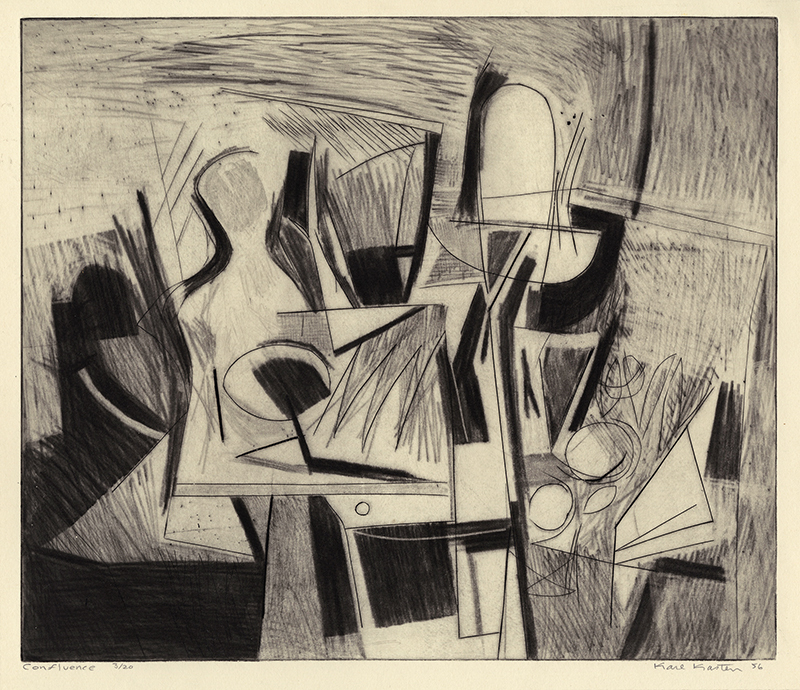
19th, 20th & 21st Century Fine Prints
707-546-7352 · fax 707-546-7924 · web: www.annexgalleries.com · email: artannex@aol.com
Confluence (also called "Still Life") by Karl Kasten

Confluence (also called "Still Life")
Karl Kasten
Confluence (also called "Still Life")
Karl Kasten
1916 - 2010 (biography)Karl Kasten used a roulette wheel in this abstract, somewhat cubist still life. He creates deep black shadows with the tool and uses it to "draw" the soft grays and then reinforce the image with delicate engraved lines. He titled the initial proofs "Still Life". Kasten printed this edition of 20, the second state of plate, titled "Confluence" later in 1956, this impression is from this edition. According to the dictionary a confluence is "a coming or flowing together, meeting, or gathering at one point'
The reverberations of Abstract Expressionism had made their mark in the San Francisco Bay Area in the previous decade when Kasten was a teacher at the California School of Fine Arts (CSFA; later the San Francisco Art Institute). By the mid 1950s, he had established himself as a leading practitioner and teacher of printmaking, as well as a vocal proponent of the exciting new genre.
Karl Kasten was born in San Francisco on 5 March 1916. After graduating as valedictorian from Marin College in 1936, he enrolled in the University of California, Berkeley where he received his M.A. in 1939. Postgraduate work included studying with Mauricio Lasansky at the University of Iowa in 1949 and with Hans Hofmann at the Hans Hofmann School of Art in Provincetown, Massachusetts in 1951.
Kasten’s distinguished teaching career began in 1941 with his appointment to the faculty of the California School of Fine Arts. This career was briefly put on hold during the Second World War while he served in the Army as a member of the Corps of Engineers. In 1946, he left California for a brief appointment to the University of Michigan at Ann Arbor, but after two Michigan winters, Kasten returned to the Bay Area in 1947. Joining the faculty of San Francisco State University, his drive and commitment to printmaking led him to plan the university's printmaking studio.
In 1950 Kasten took a position at San Francisco State University, where he developed its printmaking program, and then joined the faculty at the University of California, Berkeley, on the reccommendation of artist and friend Worth Ryder. He was a charter member of the Bay Printmakers Society and the first president of the newly formed California Society of Printmakers in 1968.
It was during the 1960s that Kasten expanded the possibilities of printmaking by developing matrixes, which consisted of vacuum-formed plastic plates with insertable parts and, in 1977, he designed the lightweight K-B etching press.


